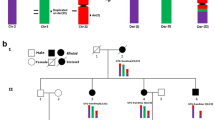Summary
In five healthy family members of three generations a reciprocal translocation, t(6;12)(q27;q21), combined with an inverted insertion inv ins (7;8)(p14;q22q13), has been demonstrated. Neither offspring with unbalanced karyotypes nor descendants with isolated translocations or insertions were observed. Five simultaneously occurring chromosomal breaks are considered to be the reason for the new rearrangement.
Similar content being viewed by others
References
Allderdice PW, Miller OJ, Miller DA (1971) Familial translocation involving chromosomes 6, 14, and 20, identified by quinacrine fluorescence. Humangenetik 13:205–209
Bass HN, Sparkes RS (1979) Two balanced translocations in three generations of a pedigree t(7;10)(q11;q22) and t(14;21)(14qter→cen→21qter). J Med Genet 16:215–218
Bell EF, Warburton D (1977) Two reciprocal translocations associated with microcephaly and retardation. J Med Genet 14:141–142
Bijlsma JB, de France HF, Bleeker-Wagemakers LM, Dijkstra PF (1978) Double translocation t(7;12),t(2;6) heterozygosity in one family. Hum Genet 40:135–147
Boué J, Boué A, Deluchat C, Perraudin N, Yvert F (1975) Identification of C trisomies in human abortuses. J Med Genet 12:265–268
Creasy MP, Crolla JA, Daker MG (1974) A familial reciprocal translocation between three chromosomes. Humangenetik 24:303–308
Dallapiccola B, Bollea G, Mazzilli C, Gandini E (1976) Complex translocation t(9;21)(9;22)(q12p13)(q12q11) in the family of a child with 9p trisomy syndrome. Hum Genet 33:73–76
Daniel A (1979) Structural differences in reciprocal translocations. Potential for a model of risk in rep. Hum Genet 51:171–182
Fitzgerald MG (1974) Complex five-break rearrangement. Clin Genet 5: 62–67
Fujita H, Abe T, Yamamoto K, Furuyama J (1974) Possible complex translocation t(9;14;13)(q12;q1?;q31) in mother of a child with 9p-trisomy syndrome. Humangenetik 25:83–92
Grouchy J de, Finaz C, Roubin M, Roy J (1972) Deux translocations familiales survenues ensemble chez chacune de deux soeurs, l'une équilibrée, l'autre trisomique partielle 10q. Ann Genet (Paris) 15/2:85–92
Hustinx TWJ, Nabben FAE, Scheres JMJC (1979) Partial trisomy of chromosome 1 resulting from a complex maternal rearrangement of chromosomes 1, 5, and 6. Am J Med Genet 3:353–358
Jacobs PA, Brunton M, Frackiewicz A, Newton M, Cook PJL, Robson EB (1970) Studies on a family with three cytogenetic markers. Ann Hum Genet 33:325–336
Jalbert P, Sele B, Jalbert H (1980) Reciprocal translocations: a way to predict the mode of imbalanced segregation by pachytene-diagram drawing. Hum Genet 55:209–222
Lejeune J, Berger R (1965) Sur deux observations familiales de translocations complexes. Ann Genet (Paris) 8:21–30
Mattei JF, Mattei MG, Coignet J, Giraud F (1978) Y autosome translocation and complex chromosome rearrangement in cri-du-chat syndrome. J Med Genet 15:154–157
Mattei MG, Mattei JF, Bernard R, Giraud F (1979) Partial trisomy 4 resulting from a complex maternal rearrangement of chromosome 2, 4, and 18 with interstitial translocation. Hum Genet 51:55–61
Martinetti J, Noel B (1973) Remaniement complexe de novo touchant quatre chromosomes chez un nouveau-né. Ann Genet (Paris) 16/4: 285–288
McClintock B (1945) Neurospora. I. Preliminary observations of the chromosomes of Neurospora crassa. Am J Botany 32:671–678
Pai GS, Thomas GH, Mahoney W, Migeon BR (1980) Complex chromosome rearrangements. Clin Genet 18:436–444
Palmer CG, Poland C, Reed T, Kojetin J (1976) Partial trisomy 11, 46,XX,-3,-20,+der3,+der20,t(3;11;20), resulting from a complex maternal rearrangement of chromosomes 3, 11, 20. Hum Genet 31: 219–225
Sanchez O, Yunis JJ, Escobar JI (1974) Partial trisomy 11 in a child resulting from a complex maternal rearrangement of chromosomes 11, 12, and 13. Humangenetik 22:59–65
Schwanitz G, Schmid P, Berthold HJ, Grosse KP (1978) Partial trisomy 13 with clinical signs of Pätau syndrome, resulting from a complex paternal rearrangement of chromosomes 6, 10, and 13. Ann Genet (Paris) 21/2:100–103
Schwinger E, Mikkelsen M, Wiesen M (1975) Familial balanced (7;11;21) translocation and Down's syndrome in two siblings. Clin Genet 7: 304–307
Seabright M, Gregson N, Pacifico E, Mould S, Ryde J, Pearson J, Bradley A (1978) Rearrangements involving four chromosomes in a child with congenital abnormalities. Cytogenet Cell Genet 20:150–154
Tanaka N, Ikeuchi T, Yara I, Kitahara K (1977) Trisomy 9p due to a maternal complex translocation involving chromosomes 4, 6, and 9. Jpn J Hum Genet 21:261–268
Author information
Authors and Affiliations
Rights and permissions
About this article
Cite this article
Meer, B., Wolff, G. & Back, E. Segregation of a complex rearrangement of chromosomes 6, 7, 8, and 12 through three generations. Hum Genet 58, 221–225 (1981). https://doi.org/10.1007/BF00278717
Received:
Issue Date:
DOI: https://doi.org/10.1007/BF00278717




